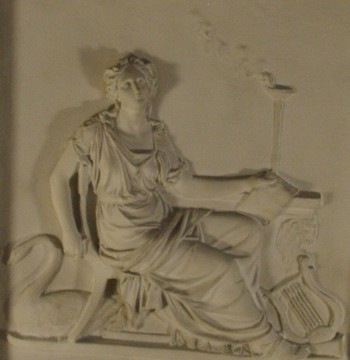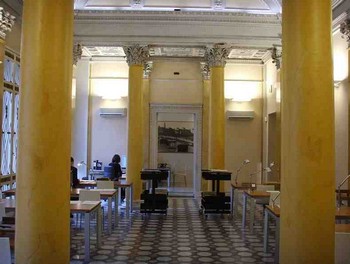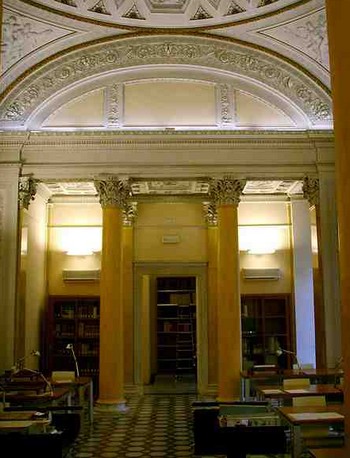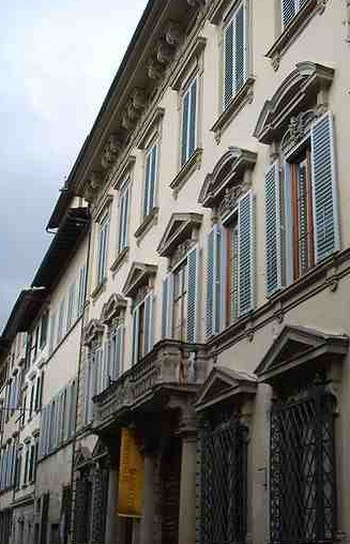Introduction
In a previous note,(1) information on unknown Minchiate produced by Giuseppe Berrettari has been reported, which derived from a small register of “Amministrazione del Registro e delle Aziende riunite” of Tuscany, within the the Siena section of the corresponding archive group, kept in the ASF.(2) These Minchiate were indicated as puzzling, in the title itself of the note, because several questions remained open, in spite of a number of interesting details reported.
In that occasion, I did not achieve a clear-cut and exact distinction between open questions and questions answered: to begin with, I inserted among the open questions some that could already be answered with the information available. For instance, the “open” question “Risma, mano, foglio?” had already found its answer with the data of the register. Similarly, the “open” questions Paper and Sheets were already satisfactorily answered by the detail present in the register, and discussed in the note.
On the other hand, one question that appeared as answered was that of the time interval of Berrettari’s production, from November 1821 to May 1829 – in agreement with the initial and final records in the register. In particular, the possibility that other similar registers could exist before and after this one could be excluded. As a matter of fact, in the months before, Berrettari’s production was recorded together with that of the other Florentine makers in other official registers of Azienda delle Carte da giuoco, belonging to another series of the same archive group.(3)
On the other extreme, any production later than May 1829 could be excluded, because of a Sovrano Motu Proprio, which stopped that whole production. It appeared thus worthwhile to search for this particular decree, in order to verify whether it could provide some useful detail.
Here I am reporting the corresponding new information, from a document found in the Archivio Storico del Comune di Firenze, or ASCFi. In the meantime I could also study in the ASF another register of the series examined, with further information that can complement the data already known.
1. Archivio Storico del Comune di Firenze
In Italian main towns, it is a rather common situation to find two parallel historical archives, Statale and Comunale, state and town archives - Florence is no exception. There is no coincidence between the two archives, the local archive being mostly formed with more recent documents coming from the local administration; we thus find, on the average, fewer documents in the town archives, and especially less ancient ones.
As usual, the edifice of the ASCFi is not a common one, in this case it is Palazzo Bastogi, more recent than other historical palaces of the town centre, having been built mainly in the 18th century, but similarly prestigious.(4) It is located in front of the Biblioteca delle Oblate, very near to the Duomo.
The archival items kept in the ASCFi are more than thirty thousand.(5) This is not comparable with the countless documents available in the ASF; nevertheless, it is possible to find here items of local interest that are not present, or just not easy to find, in the ASF.
In particular, they have a rich collection of original prints of the Florentine laws, “Leggi e Bandi”, ordered chronologically in many volumes of the time and consequently I searched there for the Motu Proprio in question. I could not find it there, but a useful surrogate is present in the form of an official Circolare,(6) a circular letter of the administration, which is based on the decree searched.
2. The Circolare and the new evidence
The Circolare under examination consists of three large pages of printed text.(6) It is related to various changes in the administration, which were introduced by two decrees of the Grand Duke, dated 15 April 1829. We are only interested in one of them, and only in its part involving the production of playing cards. The relevant paragraphs of the Circolare have been verbatim copied in the Appendix. Let us examine a few points stated or implied in the text.
Actually, several answers that we were searching can easily be inferred from the Circolare. In addition to the factories authorised by the Azienda delle Carte da giuoco, in which independent cardmakers were active, a factory had been established, managed directly by the Azienda itself, with the aim to produce and supply precisely Minchiate, and only them.
In 1829, the Grand Duke decided to introduce changes into several sections of the administration, with the explicit aim to reduce expenses and enhance the efficiency of the offices. In this action of reform, the section involving playing cards was included.
The factory, which produced Minchiate had to be closed, and their production had to be kept back by the authorised Florentine cardmakers. A direct production and trade of Minchiate from the Azienda was no longer allowed. If this could cause problems to the customers, some arrangement had to be searched with Florentine cardmakers.
3. Discussion and comments
The starting point is clearly the situation that had been indicated in the previous note,(1) and the several open questions listed there.
Siena? The first open question was related to the place of Berrettari’s workshop, especially whether in Siena or in Florence. If in Siena, it was hard to conform with the absence of any mention of a Siena production, nor of any inspection into a factory there in the official registers of card products in Tuscany compiled by the Florentine Ufficio del Bollo. If in Florence, it was hard to explain why in those years Berrettari and his production were no longer listed in the same registers together with the other Florentine makers.
Here too, we obtain no explicit information on the place of the factory. However, the possibility that it was located in Florence acquires a much greater probability now, because there is no more a reason that it should have been included together with the other factories. Indeed, this was a special factory, different from those of the Florentine cardmakers active at the time.
Il Fabbricante. The maker was Giuseppe Berrettari, both before and after 1821. However, even if he obviously remained the same person, we learn now that his activity as a cardmaker changed remarkably. Earlier on, he was an independent maker, as his Florentine colleagues; later on, he was just an employee of the Azienda delle Carte da Giuoco. It was the Azienda itself that produced these Minchiate, and Berrettari was only the salaried leader of the staff.
For the moment, we have no information about his activity after 1829; it is possible that he was no longer involved with the production of playing cards and remained a civil servant in the administration.
Ordinary cards? It had appeared somewhat surprising that ordinary cards were not present together with Minchiate. In particular, we were left with the question whether the other cards could have been recorded separately, in a different register, possibly not preserved together with that under examination. Now, this question is completely solved: ordinary cards were not recorded in another register – they did not exist at all, because the factory in question had been established just for producing Minchiate.
Various patterns? We had found no less than four different attributes for the Minchiate varieties produced, Antica, Vecchia, Moderna, Nuova. I supposed that there existed only two different kinds of products, the old pattern, indicated as either Antica or Vecchia, and the new pattern, indicated as either Moderna or Nuova. This plausible interpretation is still waiting for confirmation from other documents, or from comparison with the cards themselves, if owned by lucky collectors.
Imperial and Royal Court. The number of packs explicitly indicated as made for the Court was not negligible, and more could have the same destination without mentioning it. This is now easier to understand: if there was a card factory directly managed by the Azienda, it becomes obvious that there was no need to acquire Minchiate from the independent makers; the Court could easily be supplied by this factory.
Regrettably, we have no information on the presence of different patterns of Minchiate among those produced by the other makers, but if the old-fashioned kind was then losing popularity among the players it is easy to think of a direct influence by the Court in safeguarding the old models, which apparently were still more valued by the high classes. What is easy to imagine is that this part of the production, at least, could not be lucrative enough.
Parallel with independent makers. The almost fifty-fifty contribution to Minchiate production by independent makers and by the factory of the Azienda is not easy to interpret. There are obvious preferred destinations for the products of that factory, to begin with exports and supply to the Court.
The problem is whether there could be some kind of competition in supplying Minchiate to common players of Florence, and Tuscany. As an indication we can reflect on the Motu Proprio of 1829: if the factory had been a remarkable source of incomes for the administration, it would probably have continued its activity.
We can better obtain an insight into the trend of Minchiate utilisation at the time by checking the packs produced in the following years, from 1830 on, after the closure of the factory of the Azienda. What we see is rather unpredicted, (3) because we do not find any production increase by the independent Florentine makers: on the contrary, they produced about 1500 pack per year in mid 1820s, and about 800 in the initial 1830s.
4. The second register
After the publication of the study on card production in Tuscany in the years 1815-1861, I could examine in the ASF further ten registers,(7) belonging to the archival section of Ufficio del Bollo, thus obtaining some new information that may be worth communicating as soon as possible. One of these ten registers (8) is unexpectedly connected with the puzzling Minchiate discussed here and in the previous note.(1)
It is an official register, which however has a different title and different contents in comparison with the neighbouring members of the same series. It is a register with a floppy cardboard cover, in which most pages are left blank. The title is: “Registro per lo Stampatore e per i Miniatori del Giuoco di Minchiate.” We are thus in front of one printer and several painters, and the register has been initially structured in order to deal efficiently with each of them.
The staff. In the initial page we find a table of contents, indicating how the compilation of the subsequent pages had been pre-set.

Only for the first person, the printer, we find records for the whole time involved, which (not too much surprisingly for us now) corresponds to the years 1821-1829. For the remaining three persons, the painters, there are much fewer records, limited to the first months of 1821. As a result, most pages of this register are empty; in particular, for the three last workers we only find two half pages for each of them, separated, and followed, by many blank pages.
It is a bit surprising to find a woman at work in this factory. At the time, and for many years later on, this was more usual in the case of cottage industry; which could have been possible in this case too, based on a home delivery and pick-up service. We can consider this hypothesis somewhat confirmed by the fact that, differently from all the other workers, the entries of Fulvia Magnelli were not signed by her, but by a certain Stefano Picchi. (As a fully reliable proof this cannot be assumed, however, because women who by then could write or sign up were very few as well.)
Gaetano Piattoli is the least active. Nevertheless, he is the only member of a Florentine family already known to us as cardmakers – with Benedetto Piattoli present in earlier documents.(9) His presence in the staff can be taken as an independent confirmation that the Minchiate factory was actually located in Florence.
The job and its establishment. From the first records in the register we obtain a twofold information at the same time, when the activity began and how the job was organised. Actually the printer received the first stock of paper sheets from the Azienda on January 9, 1821. This can be considered as the initial date for the new enterprise. On his turn, the printer returned on February 8 the equivalent of 80 Minchiate packs printed.
Now, it was time for the painters to begin their job too, and indeed we soon find the mentioned 80 “packs” forwarded to them, 45 on 9 February to Gaetano Piattoli, 15 on the same day to Fulvia Magnelli, and 10 on the next day to Gaetano Calamandrei. (In the case of the first painter, this represented the whole lot processed by him.)
A standard finished pack was included in the first consignment to the three painters, to be used as sample, and then returned to the Azienda together with the last products.
The products. The entries for the three painters are easier to understand and to summarise. As usual, we have the records inserted into two pages, side by side: on the left the sheets received to be painted, on the right the sheets finished and returned to the office. In any case, the number of packs equivalent to the sheet number, namely one fourth of them, is always indicated.
I will only reproduce in the following table the dates of the Minchiate “packs” returned, a few days after the corresponding dates on the left page. All the records are provided with the corresponding number of paper sheets, but these I have not copied, because they are just four times the pack numbers, everywhere. The year is 1821, for every instance here.
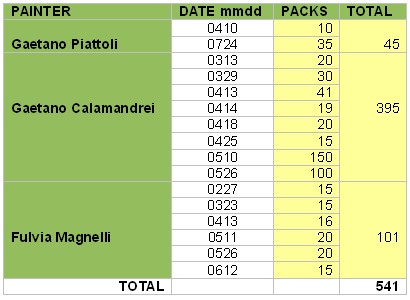
The records for the printer are more complex, because they involve the whole nine-years interval and different kinds of paper sheets. Both watermarked and plain paper sheets were provided, but in individual deliveries the latter ones did not exactly match the quantity needed for the packs. I will thus again report only the yearly amounts of Minchiate packs in the table below. (For the last year, the amount in brackets is for remaining watermarked sheets, still to be printed.)
In order to make a comparison easier, I have added a third column with the corresponding yearly products of Berrettari. (1)
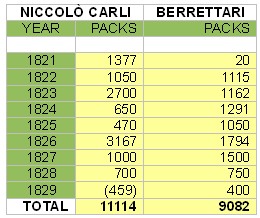
The balance. We have thus ultimately found Minchiate sheets printed for producing more than eleven thousand packs, and hardly half a thousand of them painted. It is our task to try and balance these two greatly discordant numbers. Let me just suggest a possible explanation with Giuseppe Berrettari entering the job as a substitute of the three painters, which were initially active, or just as their responsible leader, appearing from late 1821 to 1829 in the records of the other register.
Nobody can affirm that the two sets of the second and third columns reveal an exact correspondence, and only for the strong disagreement in the 1821 products we have an easy explanation ready - because the production had begun before the entry of Berrettari.
On the other hand, the two sets do not appear to be completely unrelated either. The sum of the 9082 packs recorded for Berrettari and the 541 recorded here as painted is not yet equal to the 11114 printed packs, but several explanations may be guessed to explain the difference, the simplest being that not all the sheets printed were then painted and finished.
CONCLUSION
A puzzling production of Minchiate in the years 1821-1829 is documented in a register kept in the ASF and had been described and discussed in a previous note. (1) Here further detail is added, which allows to answer several questions that had been left open.
In 1821, Giuseppe Berrettari changed his position from an independent cardmaker to leader of the staff in a factory directly established by the Azienda delle Carte da Giuoco for producing and trading Minchiate. This explains that these cards could be used without any tax stamp both for exports and for playing within the Court.
We can consider this production as a protracted experiment, which lasted for nine years and was then abandoned. Apparently, the incomes deriving from this activity were not enough to keep it going. It is likely that the initial expectations were not fulfilled; this interpretation can be corroborated by the general drop of Minchiate production that ensued in the following years in Florence.
Footnotes:
(1) Franco Pratesi: 1821-1829: PUZZLING MINCHIATE BY GIUSEPPE BERRETARI (2013)
(2) ASF, Amministrazione del Registro e Aziende riunite. Direzione di Siena. No. 692.
(3) Franco Pratesi: 1815-1861: THE PRODUCTION OF PLAYING CARDS IN TUSCANY (2013)
(4) Commons.wikimedia.org: Palazzo Bastogi ; it.wikipedia.org: Palazzo Bastogi
(5) Archivio storico del Comune di Firenze
(6) ASCFi, Biblioteca, Leggi e bandi, GF 2/36, XXIII.
(7) ASF, Amministrazione del Registro e Aziende riunite. Ufficio del Bollo Straordinario e Azienda delle Carte da giuoco, No. 149 to No.158.
(8) ASF, ibid., No. 150.
(9) Franco Pratesi: 1729-1762: EXPORTS OF FLORENTINE MINCHIATE
APPENDIX
Circolare Num. 226.
Signore
SUA ALTEZZA IMPERIALE, e REALE, il Gran-Duca nostro Signore, in seguito della riunione delle residuali dependenze dell’Amministrazione Demaniale all’altra Amministrazione del Registro, già operata con il R. Motuproprio dei 2 Aprile 1828, volendo procedere al definitivo scioglimento della Direzione Generale, che presiedeva alla prima delle predette Amministrazioni, e provvedere altresì al più economico andamento della seconda, è venuta nella determinazione di ordinare con due suoi Veneratissimi Motuproprj del dì 15 Aprile cadente.
[The text continues till paragraph VI – only paragraph III is interesting for us.]
III. “Che cessino la fabbricazione, e respettivamente la vendita delle Carte da Minchiate fin qui eseguite per conto dell’Azienda del Bollo, e riuniscansi ai Fabbricanti patentati degli altri giuochi di Carte, con tutte le regole, e discipline già per essi in vigore, rimanendo il Direttor Generale dell’Amministrazione del Registro, e Aziende riunite incaricato di concertare, occorrendo, con alcuno di loro quanto è necessario, onde in questa parte non rimanga il servizio del Pubblico pregiudicato.”
[In a second part, we find again paragraphs I-V, concerning bookkeeping and archives, probably connected with the second Motuproprio mentioned. Then the final part is as follows.]
La Direzione Generale dell’Amministrazione del Registro, e Aziende riunite deduce a notizia di tutti gli Impiegati, e Ministri da Lei dipendenti le surriferite disposizioni, ed ordini Sovrani, perché abbiano piena, ed esatta esecuzione, e possa ciascuno dei detti Impiegati uniformarvisi con precisione in ciò che concernono respettivamente le loro attribuzioni, ed ingerenze.
Non manchi di darmi riscontro del recapito della presente, che conserverà in filza di Ordini; E con distinta stima mi confermo,
Di VS.
Firenze dall’Ufizio Generale dell’Amministrazione del Registro, e Aziende riunite lì 20 Aprile 1829.
V.° A. CALAMATI
Devotiss. Servitore
Carlo Pichi
|
|



